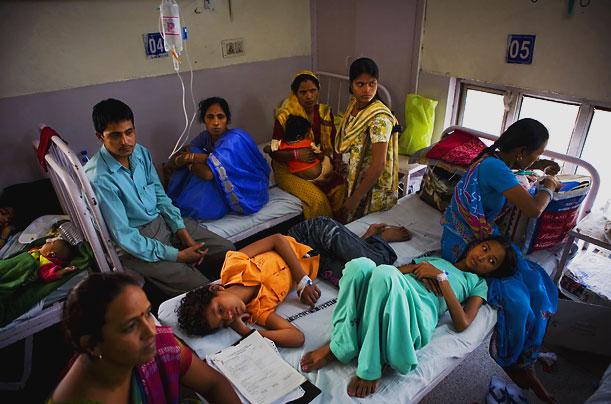NMC Act: Death Knell to Indian Healthcare System?

President Ram Nath Kovind has now signed the National Medical Commission Bill (NMC), 2019 after it was passed on August 5 by the both houses of Parliament, Health Minister Dr Harsh Vardhan said on August 9. With this, it has become crystal clear that the controversial Bill, despite having flaws which were raised by dissenting parliamentarians and angry doctors, was not questioned by the President. As there have been no sporadic skirmishes between President Kovind and the Modi Government, the assent to NMC Bill has certainly sent tremors across the medical fraternity.
The health ministry came forward defending the Act on the outline of “misconceptions” which according to Minister Vardhan unnecessarily aggravated protests. He further asserted that he had cleared the doubts of the protesters regarding the provisions of medical quackery, however, the real reason behind the slowing down of protests is the way the health ministry played down the promulgation of the Act. He offered protesting doctors a lollipop of assurance that some rules and regulations were yet to be drafted, leaving no other option for resident doctors and medical students except to return to their day-to-day work.
The minister also said that the punishment for quackery has been enhanced up to Rs. 5 lakh, along with a maximum of one year of imprisonment. But, a copy of the Act accessed by NewsClick hints at something grave. The Act incorporates no changes as suggested by the All India Institute of Medical Sciences Resident Doctors Association (AIIMS RDA)/ Safdarjung Hospital Delhi RDA (SJHDELHI RDA)/ Federation of Resident Doctors Association (FRDA)/ Indian Medical Association (IMA) Secretary. This piece discusses the key concerns of the Act which pose serious threats to the healthcare system of the country.
Shielding Quackery
The Health Workforce in India Report of 2016 authored by Sudhir Anand and Victoria Fan, under the World Health Organisation’s (WHO’s) Human Resources for Health Observer Series No. 16, highlighted the dilapidated status of Indian Medical System with critical statistical figures. It says that out of 4,81,896 health workers covered, only 23.3% of them had a medical qualification. The categories reported were of allopathic doctors, ayurvedic doctors, homeopathic doctors, Unani doctors, dental practitioners, nurses and midwives, pharmacists, ancillary health workers, and traditional and faith healers. According to the report, only 9.9% of nurses and midwives had a medical qualification while for pharmacists, ancillary health and traditional and faith healers, the figures were stagnant at 8.3%, 5.8% and 7.2%, respectively.
Also read: Will AYUSH Doctors Be Permitted to Perform Abortions At PHCs?
The above mentioned figures were widely ignored by the pro-government media and only the medical qualification figure, i.e. 42.7%, for allopathic doctors, was selectively reported. It was further denounced by then Health Minister JP Nadda who called it “erroneous”. Moreover, the other educational indicators apart from medical qualification for allopathic doctors are equally shocking. A total of 1,98,719 allopathic doctors, amounting to 31.4%, were reported to have educational qualification up to secondary schooling or less. Only 18.2% had a post-graduate degree and allopathic doctors with graduate degree were just 47.2%. The lowest 30 districts recorded for allopathic doctors with any level of education fell in the states like Meghalaya, Mizoram, Manipur, Tripura, Orissa, Assam, Rajasthan and Gujarat. Lowest 30 districts where allopathic doctors had a medical qualification were in Manipur [zero], Uttarakhand, Uttar Pradesh, Orissa, Jharkhand, Bihar, Mizoram and Nagaland. Also, to note, Uttar Pradesh had the maximum number of districts where doctors practice with minimum medical qualification, among the reported lowest 30.
Now, in order to curb the quackery, Modi Government has taken a circuitous path with Section 32 of the Act as a shield to “eliminate” quackery. In truth, the Act doesn’t work towards obviating medical quackery, but gives it now an institutionalised “protection”, referred to as “bridge course”. Section 32, as adulated by the Government of India (GoI), talks about granting licence to practice at mid-level as Community Health Provider (CHP). In addition to this, the Act allows CHPs to ‘independently’ prescribe specified medicine in primary and preventive healthcare. Section 32 (3) mentions the timely intervention by medical practitioners to supervise CHPs, however, it remains unclear how the hierarchical system will function. The Act doesn’t shed light on any internal mechanism of NMC on granting CHPs limited licences. This, if unregulated, may form an insalubrious biome of corruption where medical practitioners will entertain decisive power to approve the medical practice of CHPs or quacks in exchange of a mint. Many commentaries hail NMC as it is projected to solve the “shortage of doctors”. On the contrary, the aim of this moderation is something else; it will inflate the data on medical qualification/certification to serve the purpose of enhancing the image of Modi Government’s healthcare programme on global podium.
Autocratic Structure
The Act has been basically designed to empower the central government with draconian powers. Section 45 (2) says that “the decision of the Central Government whether a question is one of policy or not shall be final.” This means, central government can now override the suggestions by the NMC-to-be. The Act doesn’t stop here, Section 55 provides the union government with the power to supplant the Commission if GoI is of opinion that the Commission is unable to discharge the functions and duties or if the Commission has persistently made default in complying with any governmental diktat. This will crush the independence of desired body and develop a new culture of subservience to political matrix. The Act under the same clause also restricts the Commission and the autonomous boards to express their views without giving an opportunity.
The 33-member commission is set to have 29 doctors as members. The states will be represented by 10 vice-chancellors of various universities across states and nine members from various state medical councils. However, it is not necessary for the central government to consult the commission to make rules to carry out the purposes as mentioned in the Act; GoI can make rules, by notification as deposited under Section 56, regarding the appointment of Members of the Commission, the salary and allowances, and terms and conditions of the service of Chairperson and Members. Rules and regulations made by the GoI and Commission are to be laid before Parliament.
Also read: CGHS Struggles With Poor Infrastructure and Shortage of Doctors
But here is a tricky situation. Any rules made by the government can easily be passed as it enjoys the brute majority in Parliament, but when any radical or dissenting regulation is proposed by the commission, it can easily be annulled in the garb of parliamentary votes. Thus, the Act only relies on democratic structure when it favours the central government, otherwise, the subordinate bodies as envisioned in the Act have been given negligible power and authority.
The Act comes as a scathing attack on the federal structure of Indian democracy. Section 46 installs all powers in “Central Government which will direct, as it may deem necessary, to a State Government for carrying out all or any of the provisions of the Act and the State Government shall comply with such directions.”
Bureaucratic High-Handedness
It is known that administrators receive special treatment in India, after all, they are close to political executives and enjoy high-level of immunity. The bureaucrats are purported to have knowledge of almost every sector, albeit it proves caustic in most of cases in the form of failures and drawbacks of programmes. No government has worked to rescue critical sectors like healthcare from bureaucratic high-handedness. The fact that this administrative structure remains faulty as bureaucrats rarely get relegated when the ambitious programmes fail goes unnoticed. NMC Act too secures the exaggerated role of bureaucrats in NMC Act. Section 4 (3) (i) talks about representation of Ministry of Health and Family Welfare, which shall be carried out by the person not below the rank of Additional Secretary to GoI. This is a permanent seat in the commission but more important here is the process of appointment of chairperson and members of the commission.
The Search Committee, as detailed in Section 5 of the Act, shall have Cabinet Secretary as Chairperson along with Secretary to the Government of India in charge of the Ministry of Health and Family Welfare, to be the Convenor-member. This way, these two bureaucrats will dictate the constitution of the Commission, with the help “central government nominated” experts and prescribed members. This belies the government’s claim of replacing the “tainted” Medical Council of India (MCI) with NMC. The question remains, how can a democratic commission be formed if its roots are autocratic.
Dismemberment of Education
With this Act, Modi Government has proved that it has no respect for the Constitution of India. The Act is one of many efforts of this government to snatch away the powers that the Constitution grants to the constituent states of India. States, according to the Constitution, are eligible to enact laws related to public health which is extended to medical education [on concurrent list]. However, the central government has put a bar on this with Section 10 (1) (i) which gives NMC the browbeating power “to frame guidelines for determination of fees and all other charges in respect of 50% of seats in private medical institutions and deemed to be universities which are governed under the provisions of the Act.” This will only increase the scope of privatisation, thus, deteriorating the standards of medical education in India.
Amid all these, the Centre has ignored the concerns of states like Tamil Nadu. In Tamil Nadu, at least two students killed themselves because of stringent National Eligibility-cum-Entrance Test (NEET) for admission to the undergraduate medical courses. NEET was also made an election issue by the Dravida Munnetra Kazhagam (DMK) as the students vying for CBSE NEET are forced to study a different syllabus. In fact, 49 errors were found in Tamil NEET question paper of 2018. It is not difficult to conclude that NMC has pronounced the quantum of punishment for Tamil Nadu for turning its back on the incumbent BJP in recent parliamentary elections.
Also watch: Why is NEET Failing in Tamil Nadu?
One of the moot points of the protesters has been the National Exit Test or NEXT. Provisions for NEXT in Section 15 aim to regulate three objectives–(a) for obtaining licence to practice medicine, (b) for enrolment in the State Register or the National Register (c) post-graduate admission. This raises some serious questions. A student who fails to take NEXT will be disqualified for all the three. Also, the Act fails to answer how it will work to calibrate the standard of medical education uniformly among all medical institutions across the country to enable candidates to take up such competitive nationalised tests.
If these issues are not addressed by the NMC-to-be, the Act will prove none less than a tinderbox ready to blow, affecting not only medical aspirants and practitioners, and development of medical science, but also consequently the healthcare of the country at large.
Get the latest reports & analysis with people's perspective on Protests, movements & deep analytical videos, discussions of the current affairs in your Telegram app. Subscribe to NewsClick's Telegram channel & get Real-Time updates on stories, as they get published on our website.























